Orchids in water: growing features

An orchid is often called a capricious plant, but many growers would argue with this statement: not everyone knows how to properly care for a flower, which leads to certain difficulties. Orchids are known to grow on trees in their natural environment and do not need soil as such. At home, the flower is planted in the ground and its condition must be constantly monitored. But there is an alternative - growing an orchid in water.
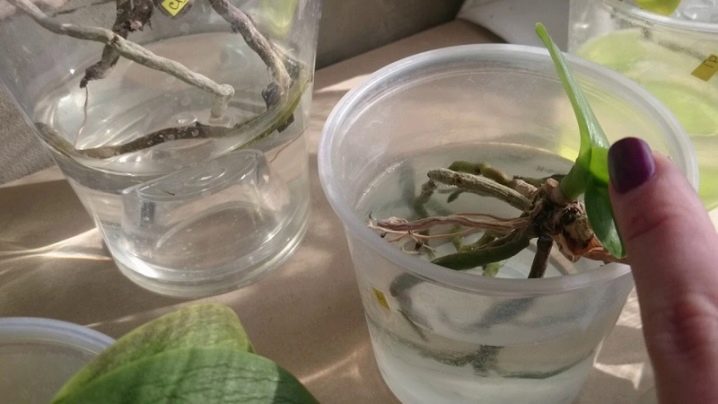
Method essence
In order for a plant to constantly delight with its flowers, it does not need ordinary water, but a specially fertilized liquid. All substances that are added to the water are determined strictly according to proportions, only this can ensure uniform nutrition of the flower.
Groundless method options:
- hydroponics - the plant is grown in water;
- aeroponics - a flower develops in the air;
- hydroculture - a substrate is added to the growing liquid.
Growing an orchid in water is not particularly difficult, it is dictated by the natural needs of the flower. Initially, it does not require soil, which is why the option of aquatic cultivation appeared. This method has many advantages, but there are also disadvantages.

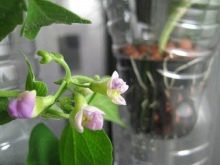
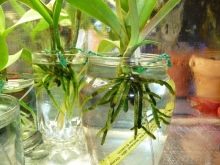
Advantages and disadvantages
Soil cultivation is inferior to hydroponics and hydrocultivation in some areas.
Benefits of growing without land.
- No rot and parasites in soil (important point). Orchid roots are initially subject to decay processes. But if you cultivate the hydroponic method, then there will be a large amount of oxygen in the water, and a regular change of liquid will also prevent decay.
- No need for regular transplant, as is the case with soil growth.
- The flower is not exposed excessive load of feeding.
- Water is constantly being enriched nutrients, so flowers grow strong and healthy.
- Roots do not dry from oxygen deficiency.
But the cons also have to be mentioned. So, the water method requires constant monitoring of the temperature of the water - it must remain cool. Also, the florist is forced to ensure that the water limit marker does not fall below the starting root system. If this happens, the liquid must be topped up.
Top dressing should be done throughout the entire growth period. This means that grooming requires regularity.
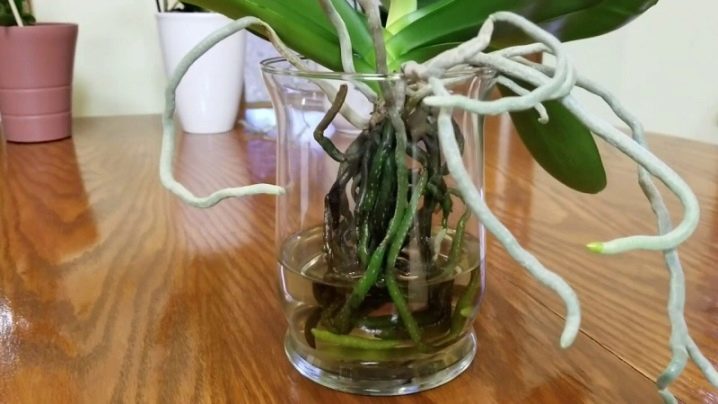
Growing algorithm
To propagate a flower, you need to make several manipulations. First, cut the peduncle off the main plant. Then prepare a bottle with a neck cut 5 cm.
Immerse the plant in water, but the water should cover the peduncle by a maximum of 5 cm. Dissolve one tablet of activated carbon in the liquid. But do not take water from the tap, the orchid needs rainwater or pre-purified water.
Then do the following:
- with a sharp blade, cut off the semicircular flake of the flower - so the closed bud will become free;
- lubricate the place of the cut with a special ointment - cytokinin ointment can be bought at any flower shop;
- apply the ointment once every 7 days for about a month;
- it is recommended to change the water and the bottle itself once a week.
You need to feed the plant throughout the entire growth period. Fertilizers should be taken all the same that are used for soil cultivation.
It is important not to miscalculate with the concentration: dilute the top dressing at a full rate from the one that provides for watering in soil cultivation.
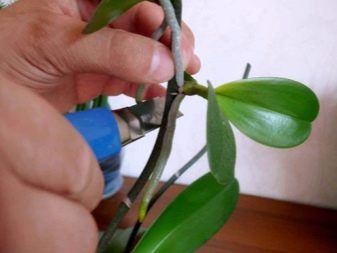
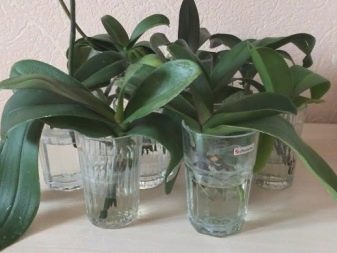
Transfer to water from soil
The plant must be adapted to the newly created conditions.
For this:
- remove the flower from the soil, clean its roots from adhering elements;
- then it is supposed to be immersed in water for about a third of the length of the roots for 2 days, after which the water is poured out, allowed to dry;
- in a week, the time for water procedures will increase to 5 days + one day for rest (it is important to let the roots dry out);
- after which the roots must be kept in water all the time, while do not forget about the regular change of water, rinse the roots more often too;
- whether the flower still needs water, it will be clear from the condition of the roots - they will become silvery.
During this period, there is an intensive growth of young roots, while faded green shoots appear on the old roots. If you see mold or whitish bloom, remove the plant from the flowerpot for a day. Then clean its roots with hydrogen peroxide or fungicidal composition.
But green algae on the roots should not be removed, they improve the air exchange of the flower.
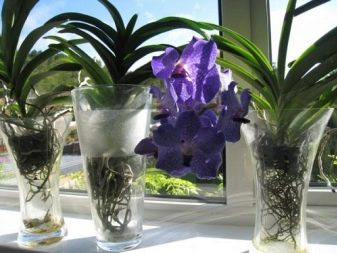
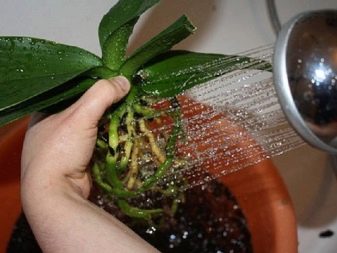
About the substrate
As noted, hydroculture is all about using a substrate, while hydroponics is just water. Many growers prefer the first option, considering it aesthetically more attractive. How much substrate you need depends on its type.
How to fill up the substrate:
- diatomite must be alternated with expanded clay, adding it to the beginning of the holes;
- expanded clay as a mono-composition should be filled up to the middle, then a flower is placed, and the substrate is added again;
- if you decide to use perlite, then the bottom is first covered with expanded clay, then the flower is placed, and perlite is poured up to a distance of 1 cm to the holes;
- the green mix is filled up, poured with water to the drainage holes, after which the plant mixture is poured.
An orchid in a pot with a substrate should stand confidently.
By choosing a bulk product, you can play up the image of a flower in an interesting way: enhance its tenderness or play in contrast.
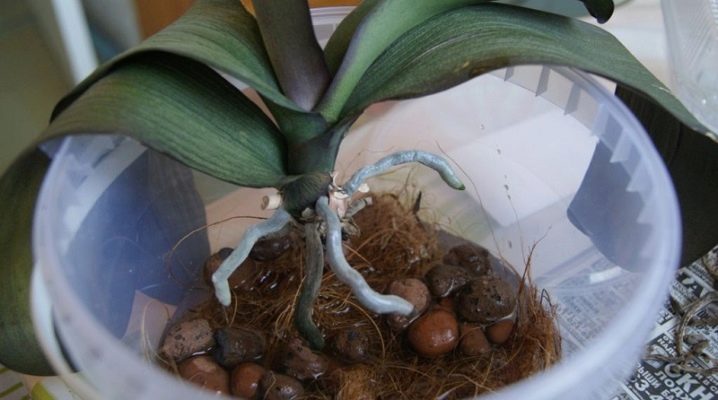
Care
The basic rule is constant monitoring of the water level. But other tips, too, should not be ignored.
Care rules:
- the temperature indicator in the room in winter cannot be below the 25 degrees line;
- to create flower buds, you need to organize a preparatory period equal to two weeks, during this time the temperature should be below 15 degrees;
- good air humidity - no more than 75%, it is fundamentally important to comply with this criterion during the period of growth of outlets, which is helped by growing in water, because the evaporated moisture increases the air humidity;
- a flowerpot with a flower is placed away from the draft, in the summer - on the balcony so that the direct rays of the sun do not injure him;
- rainwater is used for topping up, as an option - water filtered through charcoal (this is important for softness);
- the leaves of the orchid should not touch the water - this precedes decay, and if drops fall on the leaves during watering, then they are removed with a soft cloth or napkin;
- inspect and clean the holes in the flowerpots from time to time;
- replace the solution every 3 days;
- Rinse the pot monthly, wipe and dry the roots for 6 minutes, then immerse them in the solution again.

The container for growing is preferably transparent. Glass vases may seem like an attractive option, but they won't be useful. Nevertheless, this material is cold, and it is almost impossible to make normal holes in it. Therefore, flower growers choose plastic flowerpots, which are sold in flower shops everywhere.
Openings for air exchange must be in the flowerpot.
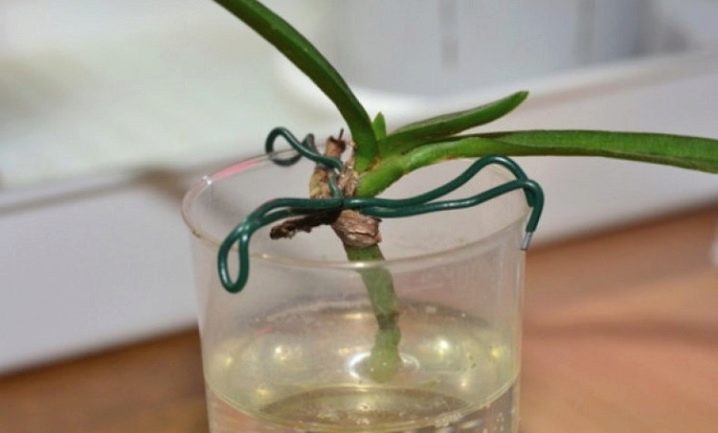
About tap water
It is not very correct to put the flower in the water from the water supply. Chances are good that the roots will start to rot. This method is strictly used to strengthen and multiply the roots. There is only one variety that can easily tolerate tap water - "Wanda". By the way, it can also be grown in a glass vase.
If you decide to keep a flower in a vase, constantly change the water, and keep an eye on the constancy of the temperature.
Sometimes between waterings, let the roots of the orchid dry out.
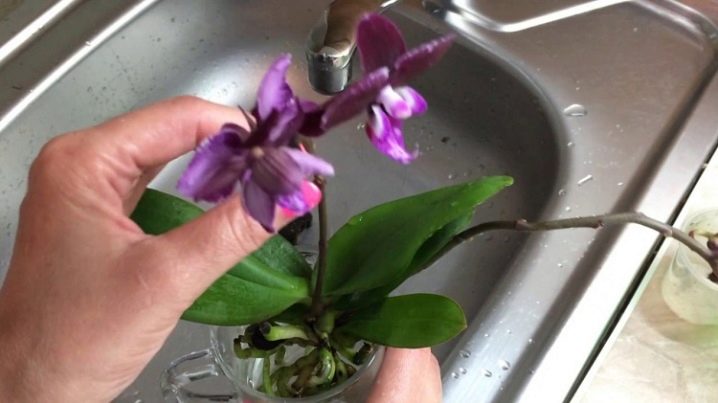
Suitable varieties
More and more new types of flowers appear on the market, but not all are suitable for growing in water. Phalaenopsis get used to hydroponics very well.
Plants without a dormant period are preferred:
- fragmipedium (otherwise it is called Venus shoes) - originally from the mountain tropics;
- cattleya - he has very large flowers, he loves warm conditions, but certainly not hot;
- dendrobium - grows in a cool natural environment;
- mormodes - has spots and dots on the petals, sepals;
- zygopetalum - it is distinguished by an unusual shape of petals.
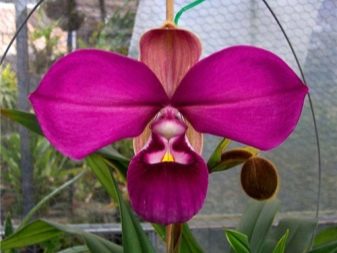
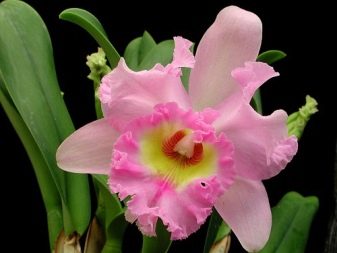
It cannot be said that a flower in water is protected from pests. And although ground parasites do not reach him, there is nowhere to hide from the flying ones. If you have fixed whitefly butterfly near the orchid, wipe the leaves with a soapy solution made in a 1: 6 ratio.
If the leaves of the flower are very wrinkled, the air is probably dry in the room. You do not need to soak the flower more, you should humidify the air. The orchid also does not like temperature changes: if it is much colder at night than during the day, the flower will "show character."
Hydroponics and hydroculture are growing methods that have grown in popularity in recent years. As flower growers note, despite the abundance of prescriptions, care cannot be regarded as very difficult, time-consuming. The only really troublesome moment is the one that requires accuracy. transfer.
If you decide to grow an orchid in a substrate with water, purchase it only in trusted stores: it is important that it is well processed and dried.
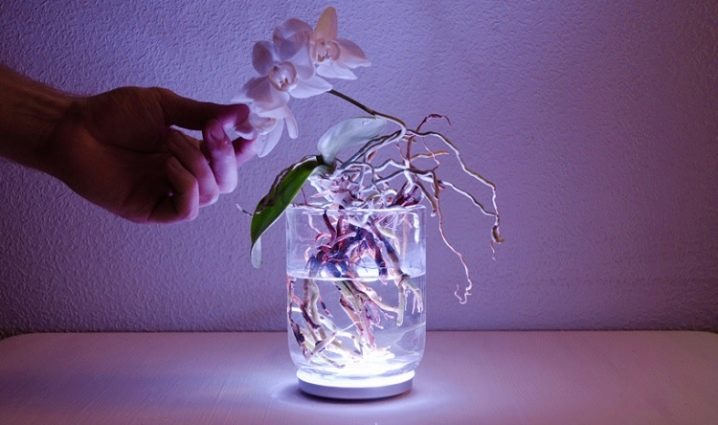
See below for more details.































The comment was sent successfully.